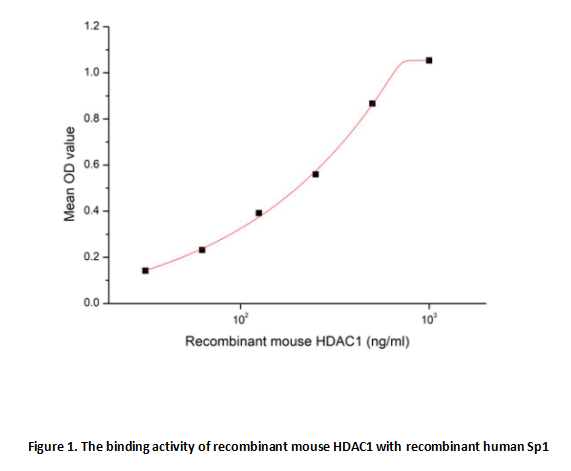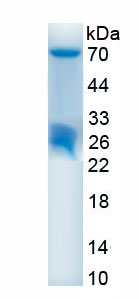Active Histone Deacetylase 1 (HDAC1) 

HDAC1; GON10; HD1; RPD3; RPD3L1
- UOM
- FOB US$ 303.00 US$ 758.00 US$ 1,516.00 US$ 4,548.00 US$ 11,370.00
- Quantity
Overview
Properties
- Product No.APC206Mu01
- Organism SpeciesMus musculus (Mouse) Same name, Different species.
- ApplicationsCell culture; Activity Assays.
Research use only - DownloadInstruction Manual
- CategoryEnzyme & Kinase
- Buffer FormulationPBS, pH7.4, containing 0.01% SKL, 5% Trehalose.
- Traits Freeze-dried powder, Purity > 90%
- Isoelectric Point5.2
Sign into your account
Share a new citation as an author
Upload your experimental result
Review

Contact us
Please fill in the blank.
Activity test

Histone deacetylase 1 (HDAC1) is an enzyme which belongs to the histone deacetylase/acuc/apha family and is a component of the histone deacetylase complex. Histone acetylation and deacetylation, catalyzed by multisubunit complexes, play a key role in the regulation of eukaryotic gene expression. HDAC1 also interacts with retinoblastoma tumor-suppressor protein and this complex is a key element in the control of cell proliferation and differentiation. Besides, Specificity Protein 1 (Sp1) has been identified as an interactor of HDAC1, thus a functional binding ELISA assay was conducted to detect the interaction of recombinant mouse HDAC1 and recombinant human Sp1. Briefly, HDAC1 were diluted serially in PBS, with 0.01% BSA (pH 7.4). Duplicate samples of 100 ul were then transferred to Sp1-coated microtiter wells and incubated for 2h at 37℃. Wells were washed with PBST and incubated for 1h with anti-HDAC1 pAb, then aspirated and washed 3 times. After incubation with HRP labelled secondary antibody, wells were aspirated and washed 3 times. With the addition of substrate solution, wells were incubated 15-25 minutes at 37℃. Finally, add 50µL stop solution to the wells and read at 450 nm immediately. The binding activity of of recombinant mouse HDAC1 and recombinant human Sp1 was shown in Figure 1, and this effect was in a dose dependent manner.
Usage
Reconstitute in 10mM PBS (pH7.4) to a concentration of 0.1-1.0 mg/mL. Do not vortex.
Storage
Avoid repeated freeze/thaw cycles. Store at 2-8°C for one month. Aliquot and store at -80°C for 12 months.
Stability
The thermal stability is described by the loss rate. The loss rate was determined by accelerated thermal degradation test, that is, incubate the protein at 37°C for 48h, and no obvious degradation and precipitation were observed. The loss rate is less than 5% within the expiration date under appropriate storage condition.
Increment services
-
 BCA Protein Quantification Kit
BCA Protein Quantification Kit
-
 Molecular Mass Marker for Protein
Molecular Mass Marker for Protein
-
 Monoclonal Antibody Customized Service
Monoclonal Antibody Customized Service
-
 Polyclonal Antibody Customized Service
Polyclonal Antibody Customized Service
-
 Protein Activity Test Experiment Service
Protein Activity Test Experiment Service
-
 Electrophoretic Mobility Shift Assay (EMSA) Experiment Service
Electrophoretic Mobility Shift Assay (EMSA) Experiment Service
-
 Buffer
Buffer
-
 Lentivirus Packaging Experiment Service
Lentivirus Packaging Experiment Service
-
 Adenovirus Packaging Experiment Service
Adenovirus Packaging Experiment Service
-
 Real Time PCR Experimental Service
Real Time PCR Experimental Service
-
 Spike RBD Protein (S-RBD)
Spike RBD Protein (S-RBD)
-
 Protein G
Protein G
-
 Protein A
Protein A
Citations
- Saponins isolated from roots of Chlorophytum borivilianum reduce acute and chronic inflammation and histone deacetylasePubmed:25609369
- Effects of tetrandrine and caffeine on cell viability and expression of mammalian target of rapamycin, phosphatase and tensin homolog, histone deacetylase 1, and histone acetyltransferase in glioma cellsScience: Article
- Uridine protects against hypoxic-ischemic brain injury by reducing histone deacetylase activity in neonatal ratsPubMed: 26410212
- Lacosamide reduces HDAC levels in the brain and improves memory: Potential for treatment of Alzheimer's diseasePubMed: 25931268
- Effects of caffeine on cell viability and activity of histone deacetylase 1 and histone acetyltransferase in glioma cellsS1016319016300295







